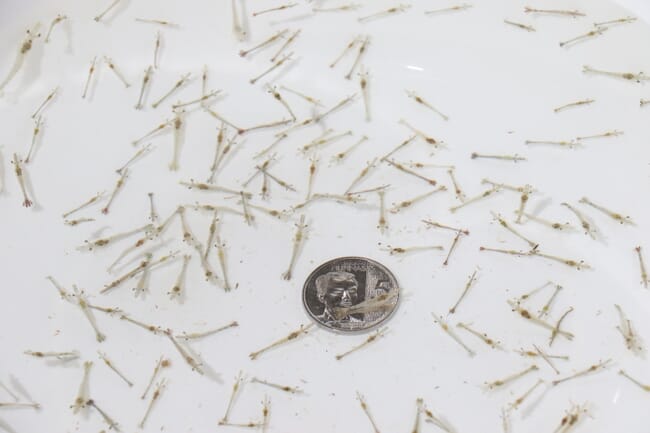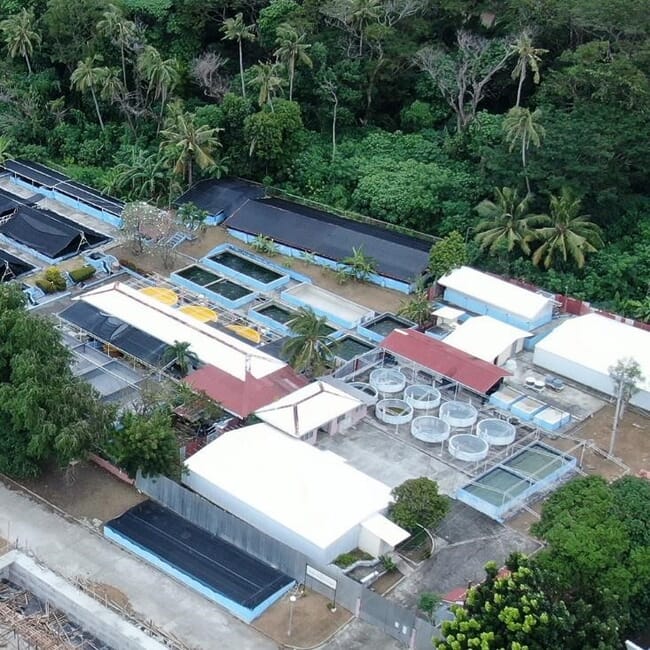
© RD Dianala
Back in 2018, at the SEAFDEC/AQD Tiger Shrimp Spawner/Broodstock Facility in Iloilo, Philippines, eggs from shrimp broodstock that were shown to contain pathogens would be promptly chlorinated and disposed of to maintain biosecurity.
The hatchery uses polymerase chain reaction (PCR) tests on the broodstock, in order to weed out any infected with white spot syndrome virus (WSSV), monodon baculovirus (MBV), infectious hypodermal and hematopoietic necrosis virus (IHHNV), yellow head virus (YHV), acute hepatopancreatic necrosis disease (AHPND), and the parasite Enterocytozoon hepatopenaei (EHP).
However, given the large number of eggs being disposed of – from 200,000 to 1 million of them per brood – SEAFDEC/AQD scientist Dr Leobert de la Peña started disinfecting the eggs and soon found that disease-free post-larvae can be successfully produced from infected broodstock.
“Now we collect the eggs from each spawner and wash them with UV (ultraviolet) light-sterilized seawater, after which the washed eggs are then disinfected with iodine before being finally rinsed with sterilized seawater,” said Dr de la Peña in a press release.
The FAO recommends that shrimp eggs and nauplii (newly-hatched shrimp) must be washed and disinfected appropriately to prevent the transmission of viral, bacterial, fungal, and other diseases from broodstock.
To date, disinfected eggs from several batches of infected broodstock at the hatchery continue to be free from diseases, helping the experimental hatchery achieve a 19 percent survival rate (from the nauplii to post-larval stage) in 2020, compared to only 9 percent in 2018, before egg disinfection was done.
Disinfection of eggs helped the experimental hatchery cut losses from the disposal of infected broodstock and their eggs. In the Philippines, a single breeding shrimp costs P1,500 to P2,000 (US$31 to US$42), while eggs that successfully develop to post-larvae are P200 to P250 (US$4 to US$5) per thousand when sold.
The measure is made even more important due to the increasing number of wild-caught broodstock purchased by the facility that are found to be infected with WSSV.
“In the mid-2000s, we found that between 0.3 to ten percent of shrimp in the wild are infected with WSSV. Recently, we found out that about 60 percent of the spent spawners that we have tested are infected,” Dr de la Peña explained.
While spawning stress may help make pathogens more detectable in PCR, the tenfold increase gives a rough estimation of the alarming spread of WSSV, which leads to significant economic losses for hatcheries.

© JF Aldon
Reviving monodon fortunes in the Philippines
The SEAFDEC/AQD tiger shrimp broodstock and hatchery facilities are at the centerpiece of SEAFDEC/AQD’s Oplan Balik Sugpo programme, which was launched in 2017 by Chief Dan Baliao, to boost the production of high-quality shrimp seeds and help revive the tiger shrimp (Penaeus monodon) industry in the Philippines.
It was once one of the top shrimp-producing countries in the world, harvesting 120,000 tonnes of monodon in 1992, worth US$300 million that year ($571 million accounting for inflation). Due to various shrimp diseases, the current national production is only roughly a third of the volume in 1992, at 42,450 tonnes, worth Php 20.60 billion.
“Technologies in shrimp farming are constantly evolving, and we, as scientists, need to adapt, depending on the current situation on the field,” said Dr de la Peña.
Chief Baliao shared that SEAFDEC/AQD is further refining its protocols and technology for future collaborations with Philippine government agencies, such as the Bureau of Fisheries and Aquatic Resources (DA-BFAR) and the National Fisheries Research Development Institute (NFRDI).
“SEAFDEC/AQD is only getting started,” he added. “There is still much to be done, but our scientists and technicians are hard at work at refining our protocols and technology for the benefit of our stakeholders.



